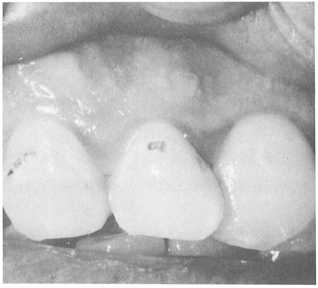
Figure 5-5. - Arrested caries.
RECURRENT CARIES
Recurrent caries are decay processes that occur underneath existing dental restorations. More simply stated, another cavity has occurred in the tooth where there was a filling or restoration. Some of the causes are as follows:
Improper cavity preparation - The dentist was unable to remove all of the decay in the tooth before the placement of a restoration.
Inadequate cavity restoration - Open margins (space in-between the restoration and tooth).
Old restorations - The margins of the restoration break down or are not completely sealed when originally placed, creating a "leaky margin."
TYPES OF CARIOUS LESIONS
Depending on its location, a carious lesion is designated as either a pit and fissure type or a smooth surface type. Pit and fissure caries develop in depressions of teeth surfaces that are hard to keep clean of food debris and plaque.
Smooth surface caries usually develop on the proximal surface (fig. 5-6) or the gingival third of facial and lingual surfaces on the teeth. These areas in-between accumulate (interproximal) the teeth are where plaque and form, starting the decay process.
DISEASES OF THE DENTAL PULP
The dental pulp is a living tissue. All living tissues can die or become diseased. The dental pulp is composed of vascular connective tissue encased in dentin, which provides protection. Even with this protection, the pulp may receive injuries by thermal changes, carious lesions from micro-organisms, and mechanical trauma. The extent of pulpal damage and the vitality (life) of the tooth depend on the severity of injury and how the pulp will react to disease. The term pulposis refers to any disease involving the dental pulp. Some of the more common diseases of the pulp are pulpalgia, pulpitis, periapical abscess, and necrosis, which are briefly explained next.
PULPALGIA
Pulpalgia refers to pain in the dental pulp, and commonly occurs after a restoration has been placed in a tooth. It can also be caused by root planing and periodontal surgery. The tooth may become sensitive to touch, temperature changes, and sweet or sour foods. Pain associated with pulpalgia has been described as short, sharp shooting pain that may increase when lying down or walking upstairs.
PULPITIS
Pulpitis is an inflammation of the dental pulp, usually caused by a bacterial infection resulting from
Continue Reading